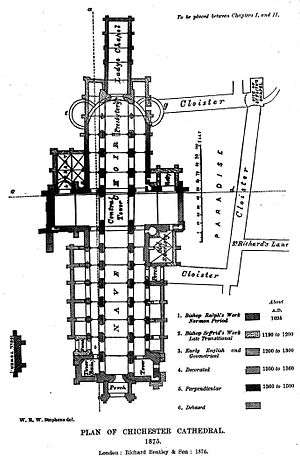Godfrey of Chichester
| Godfrey of Chichester | |
|---|---|
| Bishop of Chichester | |
| Appointed | 1088 |
| Term ended | 25 September 1088 |
| Predecessor | Stigand |
| Successor | Ralph |
| Personal details | |
| Died | 25 September 1088 |
Godfrey (died 1088) was a medieval Bishop of Chichester. The first Bishop of Chichester, was Stigand who died in 1087, it seems that he was followed by Godfrey. Confusion over the succession, was generated by William of Malmesbury, who suggested that Stigand was succeeded by a Bishop William.
Background
Following the Norman Conquest of 1066, the English church was gradually restructured along the lines of the episcopal organization in Normandy. As part of this process, almost all of the Anglo-Saxon bishops of English Sees were replaced by Normans. In 1070 Æthelric II of Selsey was deposed from his episcopate and replaced by William the Conqueror's chaplain Stigand. Then under Stigand the see was transferred from Selsey to Chichester.[1]
Life

On Stigand's death, Godfrey was nominated, by Lanfranc, Archbishop of Canterbury, in 1087-1088; his nomination is recorded in the Acta Lanfranci.[lower-alpha 1][4] Godfreys death on 25 September 1088[5] is recorded in the Annales Cicestrensis, under 1088.[6]
Little is known of his background, except he had been a royal chaplain.[7] So little was known of him, that the medieval historians, William of Malmesbury and Florence of Worcester mistakenly called him William instead of Godfrey.[8]
The historian Mayr-Harting suggests that it can be shown that William of Malmesbury and Florence of Worcester were mistaken. There could be no doubt that Godfrey was the only bishop between Stigand and Ralph Luffa. His evidence being Godfrey's profession of obedience to Lanfranc in 1088 also his name in both the Chichester and Winchester annals, and the leaden absolution that was buried with him.[6]
Lead cross
In Christianity, it was unusual for the deceased to be interred with the accoutrements of life, the only exceptions were the vestments that some great men such as bishops were buried. According to Lanfranc's Constitutions a written absolution of sins would be placed on the chest of a dead monk in their tomb, while an inscribed lead cross served a similar purpose for prelates.[9] In 1830, some workmen, digging a drain in the medieval burial ground, known as Paradise, a part of the cathedral cloisters, discovered a lead cross. Four years earlier a stone coffin had been found in the same area, it is believed that the two were linked. The cross had a Latin inscription on it, the translation in English reads "We absolve you, O Bishop Godfrey, in place of St. Peter, prince of the Apostles, to whom the Lord gave the power of binding and releasing, so that in so far as your accusation warrants and the remission pertains to us. God the omnipotent redeemer, the kind forgiver, may be to you the healing of all your sins. Amen. On 25th September, on the feast of St Fermin bishop and martyr, Bishop Godfrey of Chichester died. On the same day it was five days after the (new) moon.[4]
The first part of the text, as far as the amen, is a papal absolution relating to Godfrey.[4]
Vacant bishopric
After Godfrey's death, the see lay vacant until 1090 or 1091.[10] The 19th century historian W. R. W. Stephens said that the cause of the vacancy was due to "the grasping avarice of the red king, who protracted episcopal vacancies to the utmost extent, that he might enrich his own treasury with the temporalities of the sees."[11] The church and William II were certainly in conflict for much of his reign.[12] When bishoprics and abbeys became vacant William was able to take the revenues from them until the post was filled by a new bishop or abbot, William would often auction these positions off to the highest bidder.[13]
Notes
- ↑ The Acta Lanfranci is a Latin continuation of the Anglo-Saxon Chronicle Manuscript A (known as the Winchester (or Parker) Chronicle), that covers church events in the period 1070-93.[2][3]
Citations
- ↑ Kelly "Bishopric of Selsey" Chichester Cathedral p. 9
- ↑ Bately Anglo-Saxon Chronicle pp. 84-89
- ↑ Swanton Anglo-Saxon Chronicle p.xxii.
- 1 2 3 Okasha "Lead Cross" Sussex Archaeological Collection pp. 63-69
- ↑ Fryde, et al. Handbook of British Chronology p. 238
- 1 2 Mayr-Harting Diocesis Cicestrensis p. 65 and Footnote 6
- ↑ Barlow William Rufus pp. 93–94
- ↑ Barlow English Church p. 66 footnote 70
- ↑ Bartlett England under the Norman and Angevin Kings pp. 596-597
- ↑ Barlow English Church p. 68
- ↑ Stephens Memorials of the South Saxon See p. 47
- ↑ Starkey Monarchy p. 156
- ↑ Barlow William Rufus pp. 233-238.
References
- Barlow, Frank (1979). The English Church 1066–1154. London: Longman. ISBN 0-582-50236-5.
- Barlow, Frank (1983). William Rufus. Berkeley, CA: University of California Press. ISBN 0-520-04936-5.
- Bartlett, Robert (2000). England Under the Norman and Angevin Kings: 1075–1225. Oxford, UK: Clarendon Press. ISBN 0-19-822741-8.
- Bately, J.M, ed. (1986). Anglo-Saxon Chronicle: A Collaborative Edition: MS A. 3. Cambridge, UK: D.S. Brewer. ISBN 978-0-85991-103-0.
- Fryde, E. B.; Greenway, D. E.; Porter, S.; Roy, I. (1996). Handbook of British Chronology (Third revised ed.). Cambridge, UK: Cambridge University Press. ISBN 0-521-56350-X.
- Mayr-Harting, H. (1964). Diocesis Cicestrensis: The Acta of the Bishops of Chichester 1075 – 1207 Part CXXX. 56. Canterbury and York Society. ISBN 0-907239-04-8.
- Okasha, Elisabeth (1996). "The Lead Cross of Bishop Godfrey of Chichester". Sussex Archaeological Collection. 134: 63–69.
- Starkey, David (2004). The Monarchy of England Volume I. London: Chatto & Windus. ISBN 0-7011-7678-4.
- Stephens, W. R. W. (1876). Memorials of the South Saxon See and Cathedral Church of Chichester. London: Bentley.
- Swanton, Michael (1996). The Anglo-Saxon Chronicle. New York: Routledge. ISBN 0-415-92129-5.
| Catholic Church titles | ||
|---|---|---|
| Preceded by Stigand |
Bishop of Chichester 1088 |
Succeeded by Ralph de Luffa |